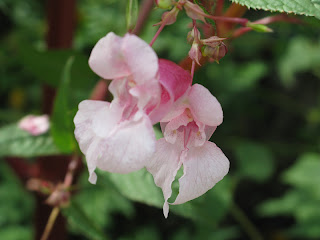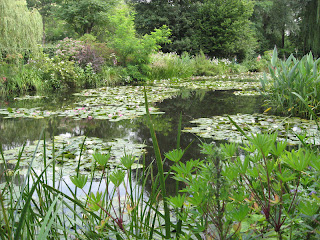We visited two museums in Giverny: the Museum of Impressionisms Giverny, and the better-known Fondation Claude Monet.
 |
| Degas: Les repasseuses |
The Museum of Impressionisms Giverny focuses on all the different forms of Impressionism, one of the most popular painting movement. Its origins, its geographical diversity, its history and development in other streams, are the themes the museum deals with. Because Giverny is not only an essential stop on an impressionist route in the Seine Valley, it is also a crucial landmark in the turn from Impressionism to the art of the 20th century.
Our main goal was to visit Monet's gardens, as we refer to La Fondation Claude Monet. It was magnificent and Karl felt it was a highlight of his trip to France this year. The ambiance is calm, peaceful and you feel at one with your surroundings. No wonder Monet was able to produce such impressive work.
At the beginning of May 1883, Monet and his family rented a house and 2 acres from a local landowner. The house was situated at Giverny. There was a barn that doubled as a painting studio, orchards and a small garden.
The house is decorated in the colour schemes that Monet admired.
Claude Monet (14 November 1840 – 5 December 1926) was a founder of French impressionist painting, and the most consistent and prolific practitioner of the movement's philosophy of expressing one's perceptions before nature, especially as applied to plein-air landscape painting. The term Impressionism is derived from the title of his painting Impression, Sunrise (Impression, soleil levant).
Each flowerbed has a colour scheme that contributes to the look of the whole garden.
The family worked and built up the gardens and Monet's fortunes began to change for the better. By November 1890, Monet was prosperous enough to buy the house, the surrounding buildings and the land for his gardens.
Look at the luminosity coming from this flower! One almost thinks there's a light bulb at its core.
Monet was fond of painting controlled nature: his own gardens in Giverny, with its water lilies, pond, and bridge. He wrote daily instructions to his gardener, precise designs and layouts for plantings, and invoices for his floral purchases and his collection of botany books. As Monet's wealth grew, his garden evolved. He remained its architect, even after he hired seven gardeners.
The Water Garden starts with a huge growth of bamboo.
The Water Garden path meanders under weeping willows, over the Japanese bridge, and around the pond filled with water lilies, a plant we most closely associate with Monet. The eye sets on countless scenes that leave artists aching for an easel.
Even the ducks appreciate the lilies in the Water Garden pond.























































Wow, this garden is breathtaking beautiful!
ReplyDelete